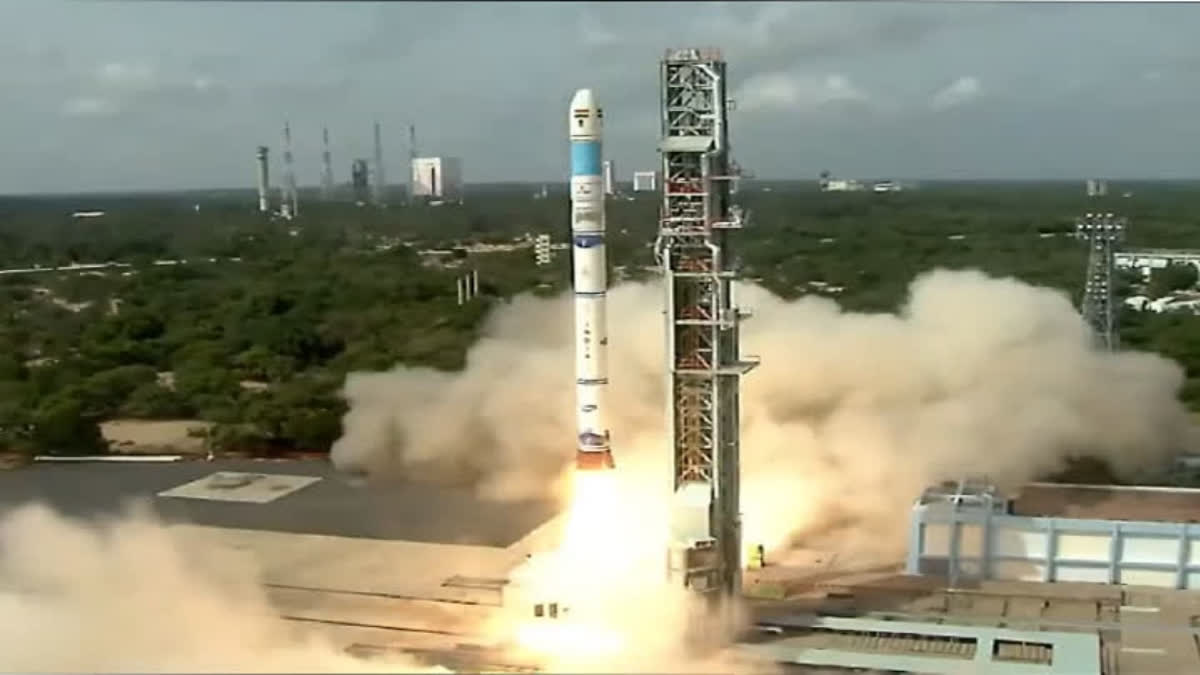Sriharikota (Andhra Pradesh): ISRO's final developmental flight, LV carrying an Earth observation satellite lifted off from Sriharikota. The mission, which carries the Earth Observation Satellite (EOS-08), marks ISRO's third launch in 2024 following the successful PSLV-C58/XpoSat and GSLV-F14/INSAT-3DS missions.
The launch was initially set for August 15 but was later rescheduled to August 16. It took place from the first launch pad at the Satish Dhawan Space Centre. The mission will deploy two satellites: EOS-08 and SR-0.
Today's mission marks the third for the Bengaluru-headquartered space agency in 2024, after the successful PSLV-C58/XpoSat in January and GSLV-F14/INSAT-3DS missions six months ago. The ISRO said, "SSLV-D3-EOS-08 Mission -- Six-and-a-half-hour countdown leading to the launch commenced at 02.47 hrs IST".
EOS-08 is ISRO’s latest Earth Observation Satellite, slated for launch by the Small Satellite Launch Vehicle (SSLV)-D3. The primary objectives of the EOS-08 mission include designing and developing a microsatellite, creating payload instruments compatible with the microsatellite bus, and incorporating new technologies required for future operational satellites.
This mission is intended to launch small satellites into Low Earth Orbit (LEO) with a maximum weight of 500 kg. It carries three primary payloads: the SiC UV Dosimeter, the Global Navigation Satellite System-Reflectometry payload (GNSS-R), and the Electro-Optical Infrared Payload (EOIR).
The SSLV-D3-EOS-08 mission will strengthen NewSpace India Ltd.'s capacity to undertake further SSLV-powered commercial launches in the future. With this mission, ISRO should be able to use cutting-edge tiny satellite technology for a variety of purposes, such as environmental monitoring, and catastrophe monitoring.
Built on the Microsat/IMS-1 bus, EOS-08 carries three payloads: Electro Optical Infrared Payload (EOIR), Global Navigation Satellite System-Reflectometry payload (GNSS-R), and SiC UV Dosimeter.
SSLV-D3/EOS-08 Mission
— ISRO (@isro) August 16, 2024
Tracking images 📸 pic.twitter.com/1TSVx19ZDk
The EOIR payload is designed to capture images in the Mid-Wave IR (MIR) and Long-Wave IR (LWIR) bands, both during the day and night, for applications such as satellite-based surveillance, disaster monitoring, environmental monitoring, fire detection, volcanic activity observation, and industrial and power plant disaster monitoring.
The GNSS-R payload demonstrates the capability of using GNSS-R-based remote sensing for applications such as ocean surface wind analysis, soil moisture assessment, cryosphere studies over the Himalayan region, flood detection, and inland waterbody detection. Meanwhile, the SiC UV Dosimeter monitors UV irradiance at the viewport of the Crew Module in the Gaganyaan Mission and serves as a high-dose alarm sensor for gamma radiation.
The spacecraft mission configuration is set to operate in a Circular Low Earth Orbit (LEO) at an altitude of 475 km with an inclination of 37.4°, and has a mission life of 1 year. The satellite has a mass of approximately 175.5 kg and generates power of around 420 W. It interfaces with the SSLV-D3/IBL-358 launch vehicle.
EOS-08 marks a significant advancement in satellite mainframe systems such as an Integrated Avionics system, known as the Communication, Baseband, Storage, and Positioning (CBSP) Package, which combines multiple functions into a single, efficient unit. This system is designed with cold redundant systems using commercial off-the-shelf (COTS) components and evaluation boards, supporting up to 400 Gb of data storage.
Additionally, the satellite includes a structural panel embedded with PCB, an embedded battery, a Micro-DGA (Dual Gimbal Antenna), an M-PAA (Phased Array Antenna), and a flexible solar panel, each serving as key components for onboard technology demonstration.
The third payload -- SiC UV Dosimeter monitors UV irradiance at the viewport of the Crew Module in the Gaganyaan Mission and serves as a high-dose alarm sensor for gamma radiation.
The payloads on board will be put to use in the next Gaganyaan Mission for a range of tasks, such as measuring UV radiation, surface wind study, environmental monitoring, and satellite-based surveillance.
The satellite employs a miniaturized design in its Antenna Pointing Mechanisms, capable of achieving a rotational speed of 6 degrees per second and maintaining a pointing accuracy of ±1 degree. The miniaturized phased array antenna further enhances communication capabilities, while the flexible solar panel incorporates a foldable solar panel substrate, GFRP tube, and CFRP honeycomb rigid end panel, offering improved power generation and structural integrity.
A pyrolytic graphite sheet diffuser plate, known for its high thermal conductivity of 350 W/mK, reduces mass and finds application in various satellite functions. Furthermore, the EOS-08 mission adopts a new method of integrating housekeeping panels using a hinge-based fixture, significantly reducing the duration of the Assembly, Integration, and Testing (AIT) phase.
EOS-08 marks a significant advancement in satellite mainframe systems such as an Integrated Avionics system, known as the Communication, Baseband, Storage, and Positioning (CBSP) Package, which combines multiple functions into a single, efficient unit.
This system is designed with cold redundant systems using commercial off-the-shelf (COTS) components and evaluation boards, supporting up to 400 GB of data storage. Additionally, the satellite includes a structural panel embedded with PCB, an embedded battery, a Micro-DGA (Dual Gimbal Antenna), an M-PAA (Phased Array Antenna), and a flexible solar panel, each serving as key components for onboard technology demonstration.
Read More:



